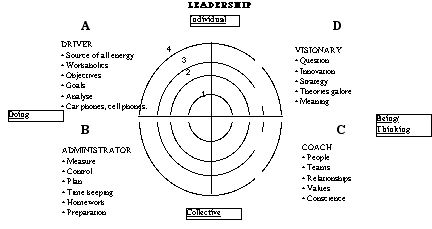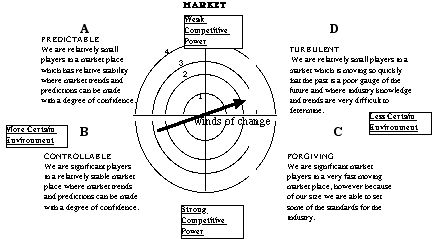
 |
| I write regular Strategic Snippets because I care about the success of your business. If you care about the success of someone else's business click "Send this page to a friend". Ask them to let me know that you were involved. |
Contact
Bruce Holland
| mob+6421 620 456 |
| Bruce.Holland@virtual.co.nz |
 |
Are you a Clever Manager or a Wise Manager?
Clever or wise
There are many clever managers around but few wise managers. Clever managers are good at left-brain activities (analysis and planning). Wise managers are good at left and right-brained activities (meaning and relationships as well as analysis and planning). This extra dimension is one of the fundamental differences between managers and leaders. Be sure to see my interview with Peter Adams, CEO of NZAID who is an example of a wise manager.
In terms of Herrmann's Thinking Preferences, left-brain types are "Drivers" and "Administrators", and right-brained types are "Coaches" and "Visionaries" (see chart).

Left-brain managers have a preference for doing. They don't like too much talking or discussion and dislike introspection.
Right-brained managers have a preference for being and thinking. They are aware about who they are and how this impacts on others and the organization.
The importance of Being
I find it interesting that, whenever we talk about "being" in my management workshops, many managers simply don't understand what it means. I am as guilty as most others. For example, I have just returned from my morning walk. The sun was shining, the air was fresh and clear and the birds were singing as they started their nesting, but I got at least half way through the walk before I noticed anything. This is the opposite of "being". My head was so busy with left-brain thoughts and plans that I had ceased to "be". To really "be" is to be really alive. Several years ago, Alan Burns my Investment Broker, sponsored my wife Angela and me on a silent retreat where we were not allowed to talk to anyone or make eye contact. This turned out to be a wonderful way to "be". Even now, maybe 5 years later I can close my eyes and recall exactly the sights I saw (clouds racing over the sky as I lay on my back in a grassy field), the tastes I tasted (the banana and the orange tasted like never before) and the emotional connection to others. How seldom we give ourselves the opportunity to really live.
Left or right?
Research shows that great leaders come from all quadrants (see previous Snippet) and that leadership success is more to do with a person's ability to identify talents in other people and put these to work than with our own personality or thinking preferences.
Many management writers (Tom Peters is an example) are recommending a leadership style more in line with either the "Coach" style or the "Visionary" style. This is in line with Daniel Pink's book, A Whole New Mind. Pink argues that the past belonged to left-brained types but the future belongs to right-brained types, as six aptitudes will become more important in the future. These are: 1. Design, 2. Story, 3. Symphony, 4. Empathy, 5. Play and 6. Meaning.
I think leadership needs to be both left and right brain. In saying that there are three important things to remember:
1. In most businesses the level of change is becoming greater and the market environment is becoming less certain. In these conditions, I agree with Daniel Pink, that "Visionary" and the "Coaching" leadership are becoming more important. In general terms there is a "wind of change" from left to right (and maybe upwards) in most organizations as shown in the MARKET chart below; and this implies that there should be a similar move from left to right in the LEADERSHIP chart below.

2. Leadership does not need to reside in only one person, it can reside in the leadership team, or even better, throughout the whole organisation. Strongest leadership comes when all four quadrants are represented in people who understand and truly value each other for the perspectives they bring. A good deal of my work is involved in getting the leadership team to understand and value each other.
3. In practice, since most leaders are left-brained, more development effort is needed to get people, trained in left-brained methods, to be more open to right-brained methods.
The preferences
Each manager uses all four quadrants but when you are trained how to look, you will find that most have a preference towards one (or two) quadrants.
The "Visionary" tends to be individualistic and has a propensity to think and "be, to challenge and question, search for fundamentally better ways. They tend to focus attention on the big picture, strategy, asking great questions, innovation, theories and looking for unique and different solutions. Their emphasis is on individualism, creativity and fast response. They value individualism, creativity and flexibility. Their control is achieved by commitment to a common vision.
The "Administrator" tends to value group activities and have a propensity for doing. They tend to focus attention on process, measurements, controls, analysis, plans, doing the homework and emphasising preparation. Their emphasis is on order, stability, information and control. They value stability, tradition, form, procedure and low risk. Their control is centralised, by way of explicit rules and relations.
These two leadership styles are diametrically different from each other (see the chart above). People strong in one tend to value things that are the exact opposite of the things that the other values. As a result there is a natural tension between the two groups that leads to distrust and even hostility. Have you seen this sort of thing in your management team? The irony is that, to be effective, they really need each other; otherwise they are seeing only a part of the problem and part of the solution. Perhaps the best thing about Herrmann is that these issues are brought to the surface and each person starts to see that the other person is not wrong but just different. And that this is a good thing not a bad thing.
The "Coach" likes working collectively in groups. They have a propensity to think and be. They are focused on values and developing people. Their emphasis is on cohesion, teamwork, synergy and consensus. They value loyalty, commitment and teamwork. Their control processes work through commitment to common values.
The "Driver" tends to like working as an individual, be very energetic, often to the "workaholic" stage; they are very focused on objectives ('Give me a goal and I'll go and do it!'); they hate to waste time (for them being and thinking is wasting time, doing is achieving). Their emphasis is on analysis, guidelines and sustained, high levels of activity. They value production, formality and results orientation. Their control processes tend to be centralised, by way of clear sets of operating and decision guidelines and principles.
Again these two leadership styles are diametrically opposed to each other, and need each other to be effective.
Why it matters
It is important to know the thinking of the people in the management team. If the team does not reflect all of the quadrants, it will be 'flying blind' - quite literally seeing only part of the world. The team also needs to value their differences and learn to work together in a whole-brain way.
It is important to understand your own management style and your bias otherwise you could become too reliant on only one quadrant and ignore other important aspects.
Finally, it is important to know your manager's thinking style if you want to advance in the organization.
I am privileged to work with so many wise managers. Some are strongly left-brained, some are strongly right-brained and others are a fairly balanced mix. What they have in common is the understanding that left and right-brained thinking is required in their management team; and that the team will need some help to achieve the magic that comes when all four preferences are present and working together towards the same ends.
Bruce Holland
Helps large organisations be focussed, fast and flexible. Places where people have more meaning, depth and connection.
Expert in Strategy, Structure, Culture and Leadership Development.
One of NZ's most experienced change agents.
Liberating the Human Spirit at Work


